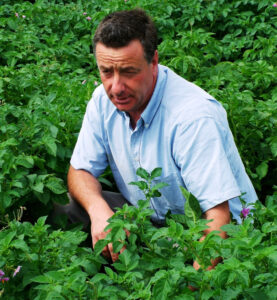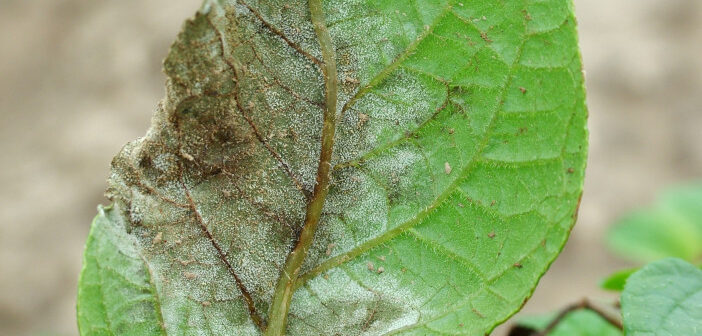Crop production specialists, Hutchinsons, have advised that growers should assess how well the herbicide spray has worked before the blight season starts, as this can indicate any errors in sprayer set up.
Potato agronomist at Hutchinsons, Andrew Goodinson, said: “Most importantly, section control must be set up accurately to cover the correct area and avoid missing any area of the crop. If you can see an area of weeds, it is very likely you missed them with the sprayer, and it is likely that you will miss them again when you go in with the blight spray. Just tweaking sprayer set-up can offer pay-back when blight pressure is high.”
Despite low blight pressure in 2022, and the likelihood of low inoculum carry-over, he warned growers to take no chances this year. He likes to start blight control programmes when the crop is at the rosette stage, following a ‘mix and match’ strategy with actives according to conditions at the time the Hutton Criteria is triggered.

Andrew Goodinson. potato agronomist at Hutchinsons
Mr Goodinson said: “We rotate out chemistry across the different fungicide groups to avoid putting a single active under pressure. The choice of fungicides is not set in stone, but very much depends on the conditions in the field at the time and we also need to follow the Fungicide Resistance Action Group (FRAG) guidelines.”
Although outbreaks of fluazinam-insensitive blight strain 37_A2 (formerly known as Dark Green 37) were less prevalent in 2022 than in recent years, he warned growers to only use it mid-programme in a mix at full rate (400ml/ha). “We used to use fluazinam for the first spray, but we now tend to opt for cyazofamid and for the second spray we often follow it with fluopicolide + propamocarb because it works well with the crop at this stage.”
Mr Goodinson said mandipropamid remains a good-value fungicide and it works particularly well as a second spray, particularly when it is mixed with cymoxanil: “Mandipropamid can be useful in unsettled weather because of the speed of its rainfastness. One of the concerns is that other actives within the same fungicide group (CAAs) may also be at risk, and therefore they should not be used alone.”
Although 43_A1 has not so far been found in Britain, it has proliferated in Denmark and has been found in Belgium and the Netherlands.
“The addition of an adjuvant with mandipropamid to reduce drift has shown better effectiveness but it will not affect the strain’s insensitivity,” Mr Goodinson continued. At mid-season he finds oxathiapiprolin very useful because it is effective, persistent and it moves well round the plant.
“Although oxathiapiprolin is one of the more expensive options, when the pressure is really high, we tend to use it in sequence with cyazofamid, fluopicolide + propamocarb or fluazinameither side.” He added that fluazinam still has a place in the strategy because of its effectiveness against sclerotinia and botrytis.
Mr Goodinson emphasised that effective blight control is about building up the product in and on the crop, to minimise the chance of missing a blight spray when wet weather sets in.
In addition to ensuring the right fungicide choice at the right time, spray operators need to choose the right spray nozzle for the particular task. He reminded growers that some of the newer blight strains are able to incubate during colder periods, and that spores can travel a long way in the wind.
He said: “We often underestimate the spread of blight inoculum from unsprayed crops, including those in allotments and gardens. If weather conditions are dry when crops are at maximum canopy, you may be able to stretch your spray intervals a little or use cheaper alternative products, but the potential impact of late blight on the investment you have made in your crops remains huge.
“Ensuring you have a robust blight programme is more essential than ever.”




